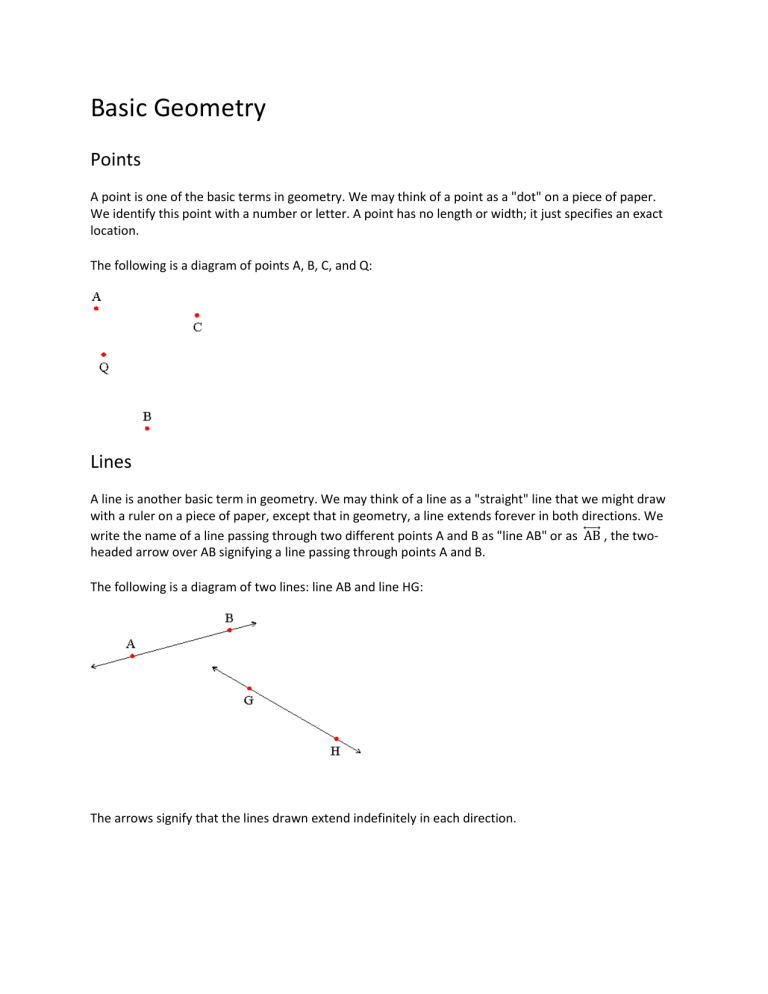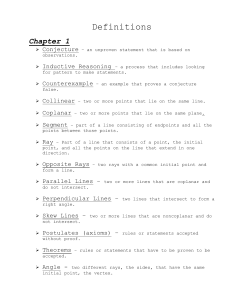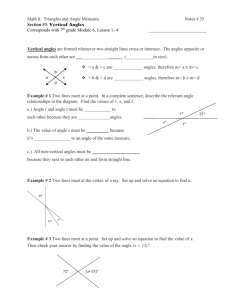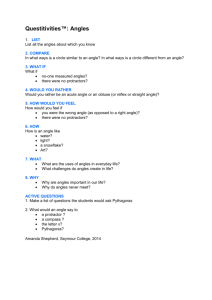Geometry overview

Basic Geometry
Points
A point is one of the basic terms in geometry. We may think of a point as a "dot" on a piece of paper.
We identify this point with a number or letter. A point has no length or width; it just specifies an exact location.
The following is a diagram of points A, B, C, and Q:
Lines
A line is another basic term in geometry. We may think of a line as a "straight" line that we might draw with a ruler on a piece of paper, except that in geometry, a line extends forever in both directions. We write the name of a line passing through two different points A and B as "line AB" or as AB , the twoheaded arrow over AB signifying a line passing through points A and B.
The following is a diagram of two lines: line AB and line HG:
The arrows signify that the lines drawn extend indefinitely in each direction.
Line Segments
A line segment is another basic term in geometry. We may think of a line segment as a "straight" line that we might draw with a ruler on a piece of paper. A line segment does not extend forever, but has two distinct endpoints. We write the name of a line segment with endpoints A and B as "line segment
AB" or as AB . Note how there are no arrow heads on the line over AB such as when we denote a line or a ray.
The following is a diagram of two line segments: line segment CD and line segment PN, or simply segment CD and segment PN.
Rays
A ray is another basic term in geometry. We may think of a ray as a "straight" line that begins at a certain point and extends forever in one direction. The point where the ray begins is known as its endpoint. We write the name of a ray with endpoint A and passing through a point B as "ray AB" or as
AB . Note how the arrow heads denotes the direction the ray extends in: there is no arrow head over the endpoint.
The following is a diagram of two rays: ray HG and ray AB.
Endpoints
An endpoint is a point used to define a line segment or ray. A line segment has two endpoints; a ray has one.
The endpoints of line segment DC below are points D and C, and the endpoint of ray MN is point M below:
Parallel Lines
Two lines in the same plane which never intersect are called parallel lines. We say that two line segments are parallel if the lines that they lie on are parallel. If line 1 is parallel to line 2, we write this as line 1 ‖ line 2
When two line segments DC and AB lie on parallel lines, we write this as segment DC ‖ segment AB.
Lines 1 and 2 below are parallel:
The opposite sides of the rectangle below are parallel. The lines passing through them never meet:
Intersection
The term intersect is used when lines, rays, line segments or figures meet, that is, they share a common point. The point they share is called the point of intersection. We say that these figures intersect.
In the diagram below, line AB and line GH intersect at point D:
In the diagram below, line 1 intersects the square in points M and N:
In the diagram below, line 2 intersects the circle at point P:
In the diagram below, Line 1 and Line 2 intersect and form a right angle at point P. We say that Line 1 is perpendicular to Line 2 or Line 1
⊥ Line 2.
Angles
Two rays that share the same endpoint form an angle. The point where the rays intersect is called the vertex of the angle. The two rays are called the sides of the angle.
Here are some examples of angles:
We can specify an angle by using a point on each ray and the vertex. The angle below may be specified as angle ABC or as angle CBA; you may also see this written as
∠
ABC or as
∠
CBA. Note how the vertex point is always given in the middle.
Many different names exist for the same angle. For the angle below,
∠
PBC,
∠
PBW,
∠
CBP, and
∠
WBA are all names for the same angle.
Measuring Angles
We measure the size of an angle using degrees.
Here are some examples of angles and their degree measurements:
The Full Circle
A Full Circle is 360°
Half a circle is 180°
Quarter of a circle is 90°
Why 360 degrees? Probably because old calendars (such as the Persian Calendar) used 360 days for a year - when they watched the stars they saw them revolve around the North Star one degree per day.
Types of Angles
A right angle is one that measures exactly 90 degrees:
An acute angle is one that measures between 0 degrees and 90 degrees:
An obtuse angle is one that measures between 90 degrees and 180 degrees:
A straight angle is one that measures exactly 180 degrees:
Complementary Angles
Two angles are called complementary angles if the sum of their degree measurements equals 90 degrees. One of the complementary angles is said to be the complement of the other.
These two angles are complementary:
Note that these two angles can be "pasted" together to form a right angle!
Supplementary Angles
Two angles are called supplementary angles if the sum of their degree measurements equals 180 degrees. One of the supplementary angles is said to be the supplement of the other.
These two angles are supplementary:
Note that these two angles can be "pasted" together to form a straight line!
Angle Bisector
An angle bisector is a ray that divides an angle into two equal angles. We say that it bisects the angle.
The blue ray on the right is the angle bisector of the angle on the left.
The red ray on the right bisects the angle on the left.
Vertical Angles
When two lines (or line segments) intersect, the angles that lie opposite each other, called vertical angles, are always equal.
Angles ∠ DAC and ∠ BAE are vertical angles and are therefore equal. Angles ∠ DAB and ∠ CAE are also vertical (and equal) angles.








